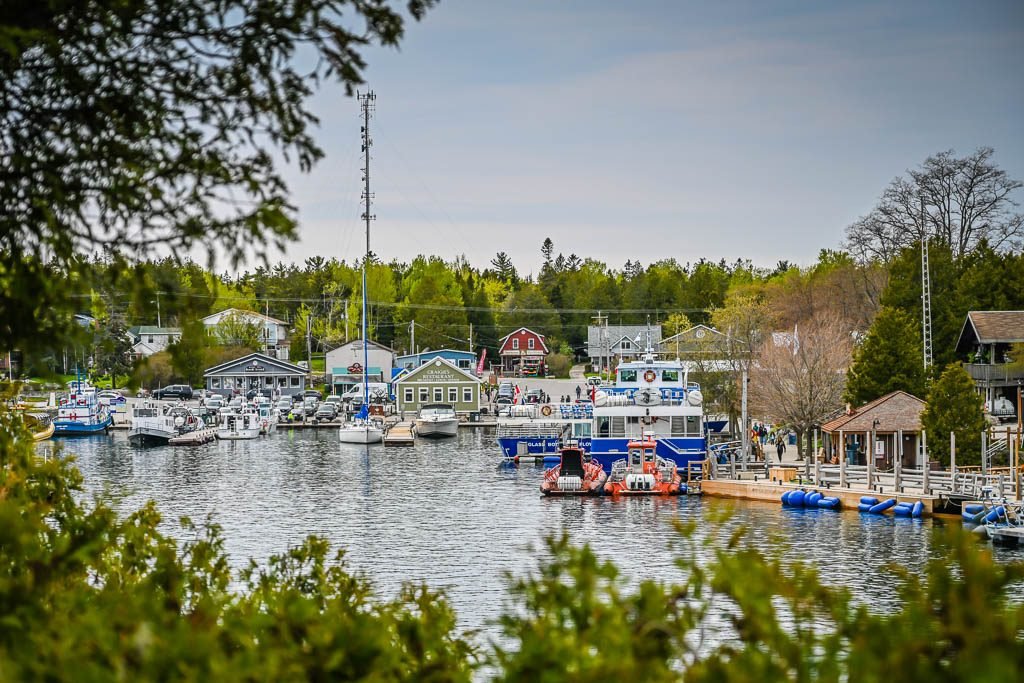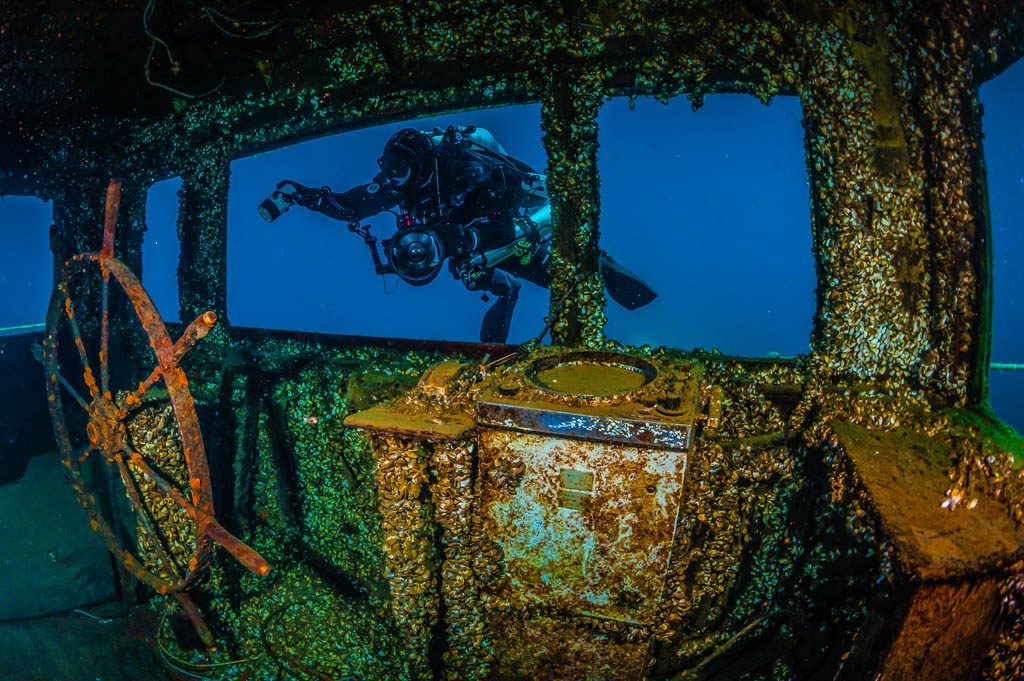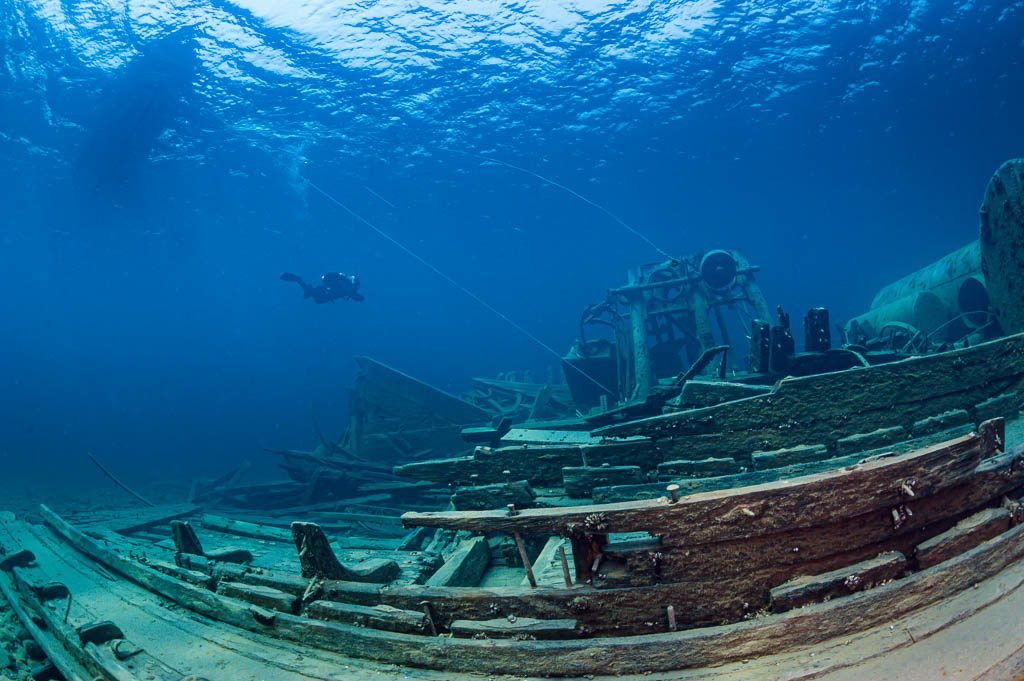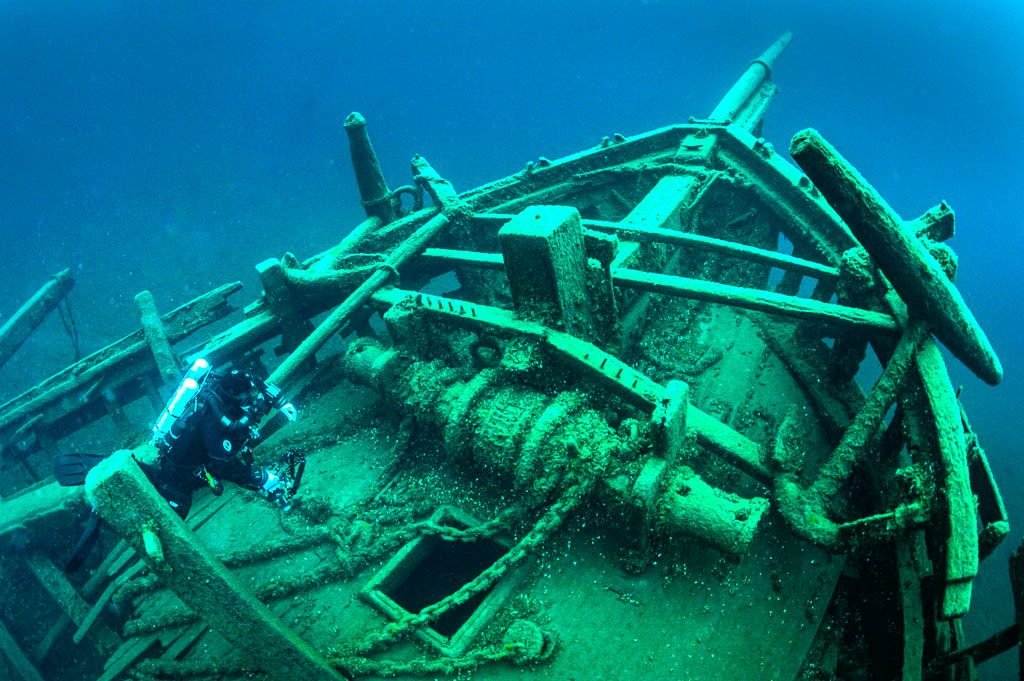
Graveyard of the Great Lakes: Tobermory’s Shipwrecks
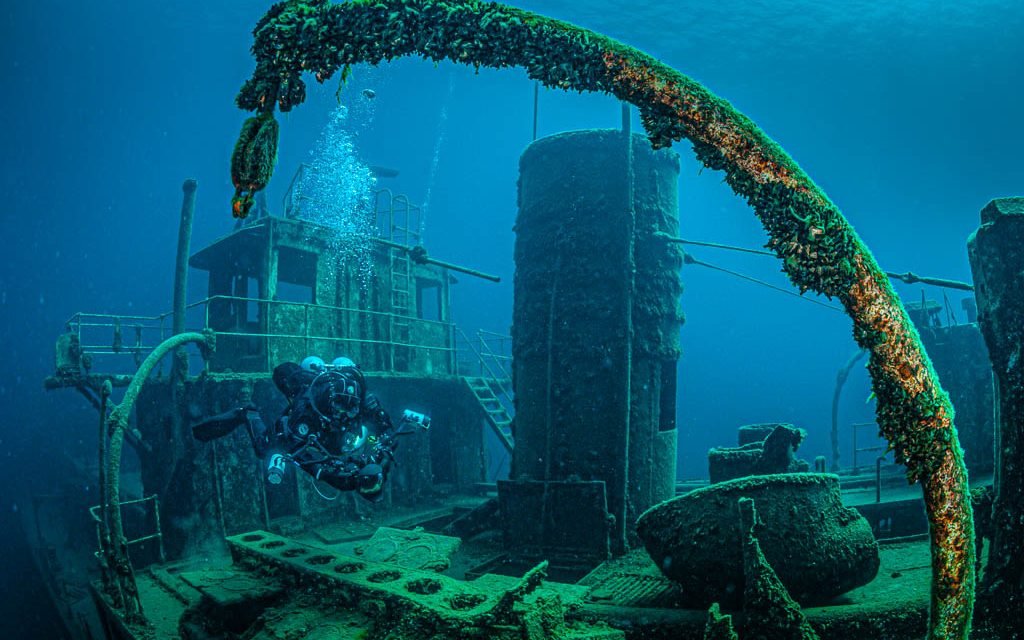
“Voyaging begins when one burns one’s boats,
adventures begin with a shipwreck.” ~ Michel Serres
Canada’s maritime history is replete with stories of ill-fated schooners, container ships, trawlers, passenger vessels and other craft that have foundered due to nasty squalls, thick fog banks, menacing currents, jagged shoals, human error and a host of other perils. Over the centuries countless lives have been lost, and thousands of storm-battered ships have been violently pulled under into the stygian depths. In reverence to the thousands of shipwrecks entombed on the bottom of Canada’s Great Lakes, mariners have ominously nicknamed this recurrent zone of death and destruction, “Graveyard of the Great Lakes”. Such fearsome notoriety inspires throngs of intrepid scuba divers each year to visit Tobermory, Ontario, to go shipwreck diving in order to explore these watery time capsules.
The 8th Wonder of Canada
Situated off the northern tip of Ontario’s picturesque Bruce Peninsula, Tobermory is a secluded harbor community which has been nicknamed the “Shipwreck Diving Capital of Canada.” Tobermory is the gateway to the Fathom Five National Marine Park, a National Marine Conservation Area covering an expanse of 80 square miles of surface water with 20 tree-covered islands, many of which have one of fifteen 19th-century lighthouses that have guided ships for over 100 years. Tourism brochures are notorious for being more colorful than reality, when they shamelessly flaunt their natural assets with grandiose statements such as, “… a place where water and land meet sky, with its 1,000-year old pines and pristine turquoise waters, you’ll see why it’s the 8th Wonder of Canada.” Indeed, Tobermory is all this, and more.
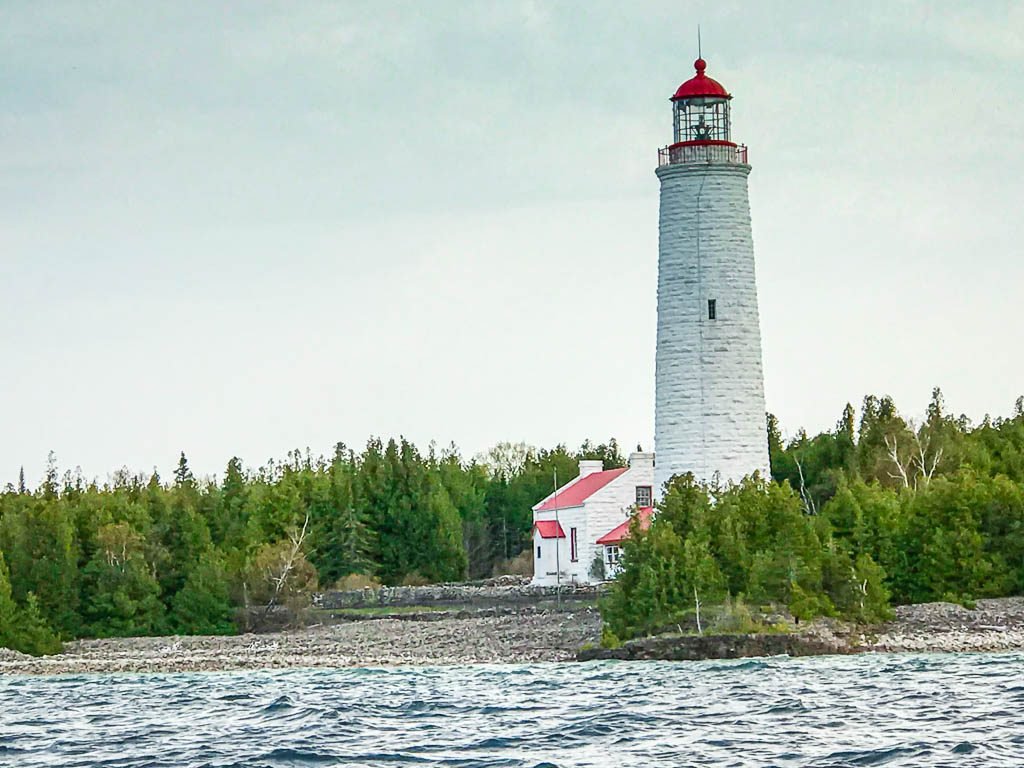
The Cove Island Lighthouse has been a navigational aid in the narrow channel between Lake Huron and Georgian Bay since 30 October 1858
Fathom Five Marine Park has more than 22 well-preserved barges, schooners and steamers within its borders – with many of these vessels dating back to the mid-1800s. Several more historical shipwrecks lie outside the park’s boundaries. Shipwreck diving depths range between 10 to 150 feet. Many mariners and passengers’ lives were lost over the past century when large steamers, wooden schooners tugs, and leisure yachts slipped into a watery grave after slamming into shallow hidden shoals during savage storms, overwhelmed and capsizing from huge waves, or in dense fog colliding into the side of one of the peninsula’s cedar-crowned islands.
Specialized Wreck Diver Training
Diving on shipwrecks, or wreck diving, can be defined as any dive on a man-made object. It is one of the more popular specialty activities for scuba divers the world over. Wreck diver training courses that educate sport divers on the proper use of lights, penetration lines and reels, air management, limited-visibility diving techniques and emergency procedures are readily available through local scuba retail outlets. These programs also help prepare underwater explorers to recognize the possible dangers of swimming in and around shipwrecks. Before anyone can go explore sunken ships, they minimally need to be at least 15 years of age and have obtained their open water scuba diving certification. It is recommended that novice divers follow up their basic scuba training with some specialized wreck diver training. Since shipwrecks are found at a range of varying depths, within diverse marine environments, they offer challenges for seasoned veteran and novice divers alike.
Wreck diving’s inherent dangers must not be ignored, so it is essential to have both the proper training and equipment for this adventurous activity. It also helps to have someone like our friend, Stuart Seldon, a local diving legend who has explored Tobermory’s shipwrecks countless number of times who escorted us on a magical mystery tour of his favorite wreck sites.
Reality vs. Hollywood
Among shipwreck diving’s many attractions, discovering a piece of history or the mere thought of possibly being the first to see a wreck that has sat undisturbed for decades or even centuries on the lake-bed is an exciting prospect. Exploring a shipwrecks maze of inner corridors or swimming the entire length of a promenade deck where passengers from another age once strolled is a unique and humbling experience. Of course, there is always the distinct chance one might uncover a rich treasure trove of artifacts. Shipwrecks in some places attract a wide-ranging assortment of marine life, making wreck sites extremely appealing for fish watchers and underwater photographers. There is also something fascinating about seeing the ghostly skeleton of a shipwreck resting upright in the depths.
Some people are surprised to learn that shipwrecks often bear little resemblance to Hollywood’s pristine portrayals of largely intact treasure ships lying bolt upright on the lake floor with their sails unfurled. On the contrary, the same forces of nature that dragged the vessels beneath the waves continues to assail them underwater. Over time, wrecks crumble or break apart because wood rots and steel rusts in a watery realm. Sometimes all that remains of a decomposing shipwreck are collapsed decks, broken sections of hull plate, boilers, portholes, ballast rocks, anchors, chains and other scattered debris. The shuddering instant a ship slips beneath the waves and settles on the bottom it becomes part of the marine ecosystem.
Shipwreck Fever
Natural shipwrecks are often laden with historical artifacts, hidden cargo, and relics associated with daily shipboard life. It’s this blend of history connected to the loss of human life that often jump-starts the sense of exploration and discovery for many sport divers, propelling them to learn how to wreck dive. Some simply refer to this malady as “Shipwreck Fever,” that overwhelming magical desire to assume the guise of an undersea pirate who pillages, plunders, rifles and loots. Crockery emblazoned with the vessel’s emblem is a much sought-after prize for some wreck divers. Fortunately, there is a big contingent of wreck divers who are highly conservation-minded about preserving the historical and recreational value of shipwrecks. They resist the temptation to collect artifacts by adopting a more responsible attitude towards preserving shipwrecks that are akin to being aquatic time capsules. By adopting a “leave only bubbles and take only memories” viewpoint, there is significant hope that future generations will be making their own exciting wreck dives into history.
Submerged Time Capsules
Shipwrecks are unrefined history beneath the waves that holds endless fascination for divers and non- divers alike. Marine archaeologists and historians categorize shipwrecks as being submerged time capsules that may contain the only remaining historical evidence of the wreck incident, the passengers and crew, or the ship’s design. Hence, some wreck divers soon discover they have an incredible passion for diving deep into old archives in libraries for documentation about specific shipwrecks. Not unlike meticulously joining the pieces of a complex jigsaw puzzle, the search for evidence of past marine activities in Canada’s Great Lakes can be both invigorating and exhaustingly time consuming. One of the best ways for wreck detectives to learn more about the fundamentals of underwater archaeology is to join a group who is dedicated to conserving, preserving and protecting Canada’s maritime history.
Protecting Historical Shipwrecks
One important concern in bringing shipwreck artifacts to the surface is that they deteriorate more quickly when exposed to air. To help preserve our marine heritage and prevent rogue divers from salvaging removable artifacts from shipwrecks, several marine archeological groups who are dedicated to the conservation of marine heritage have sprung up across the country. These, mostly non-profit, societies focus their efforts on having certain old shipwrecks designated as historical sites. These groups have been instrumental in convincing many jurisdictions in Canada to enact legislation that prohibits the plundering or taking of artifacts from shipwrecks. However, these laws do not prevent recreational sport diving, underwater photography, or any non-destructive archaeological activities taking place at wreck sites. It is believed that protecting historical shipwrecks is in the public’s best interest because if everybody were allowed to dive on wrecks and pilfer souvenirs for their personal collections, the artifacts provenance or context is lost and with its valuable archeological data about our marine heritage.
Graveyard of the Great Lakes
Ancient myths of rebirth and renewal often affirm that life can be renewed. In the sepulchral depths of Canada’s “Graveyard of the Great Lakes”, it seems myth may have some foothold on reality. For beneath Tobermory’s chilly depths, many sunken ships are clearly experiencing a second life after death as wreck dives. With the increasing availability and advancements of new technologies such side scan sonar imaging and the more prevalent use of enriched breathing gases, permitting modern scuba divers to descend to deeper depths for longer periods of time, the exact location of more and more of the Great Lake’s undiscovered shipwrecks are being revealed. Whether one is enthralled by searching for antiquities, submerging themselves into marine archives, or taking underwater photographs of shipwrecks, Tobermory’s shipwrecks provided a glimpse into the past that many recreational sport divers find extremely hard to resist.
Until our next dispatch, dare to Explore… Dream… Discover.
If You Go
Currently, Diver Den Dive Shop is the only dive store in town, but their staff sure did take care of all our needs for lead weights and air fills. The shop also runs a fleet of eight dive boats.
Please note: All divers must register and purchase in person a dive pass prior to diving from the Parks Canada Visitor Centre in Tobermory or Divers Den can issue both the day passes ($4.90) and annual passes ($19.60).
DIVERS DEN: https://www.diversden.ca










